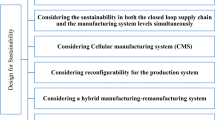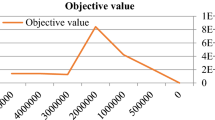Abstract
Societal awareness and legislation changes concerning sustainability have affected how organizations generate value for stakeholders, as well as their processes, products, and public relations. In the context of increasing environmental and social awareness, more studies are needed regarding reverse logistics lot-sizing control taking into account sustainability principles. The contribution of this study is the incorporation of sustainable costs in reverse logistics processes using the Economic Order Quantity (EOQ) model. This paper proposes the extension of a mathematical model for lot-sizing in the reverse logistics that considers environmental, social, and economic parameters. A numerical example and sensitivity analyses are presented to evaluate the sustainable EOQ. Our results indicate that carbon prices have a significant impact on the remanufacturing tax, i.e. the proportion of reusable items in a reverse supply chain that are successfully remanufactured. Additionally, a perspective on the social impact on lot sizing is discussed by noting that high social costs, calculated as a function of ergonomic conditions, can invalidate a high remanufacturing tax. As a consequence, poorly planned labour conditions in reverse logistics can lead to lower recycling rates due to inefficient use of social resources.
Similar content being viewed by others
References
Alinovi A, Bottani E, Montanari R (2012) Reverse logistics: a stochastic EOQ-based inventory control model for mixed manufacturing/remanufacturing systems with return policies. Int J Prod Res 50(5):1243–1264
Andriolo A, Battini D, Gamberi M, Sgarbossa F, Persona A (2013) 1913–2013: the EOQ theory and next steps towards sustainability. IFAC Proc Vol 46(9):1708–1713
Andriolo A, Battini D, Grubbström RW, Persona A, Sgarbossa F (2014) A century of evolution from Harris’s basic lot size model: survey and research agenda. Int J Prod Econ 155:16–38
Andriolo A, Battini D, Persona A, Sgarbossa F (2016) A new bi-objective approach for including ergonomic principles into EOQ model. Int J Prod Res 54(9):2610–2627
Arslan MC, Turkay M (2013) EOQ revisited with sustainability considerations. Found Comput Decis Sci 38(4):223–249
Battini D, Glock CH, Grosse EH, Persona A, Sgarbossa F (2017) Ergo-lot-sizing: an approach to integrate ergonomic and economic objectives in manual materials handling. Int J Prod Econ 185:230–239
Bazan E, Jaber MY, El Saadany AM (2015) Carbon emissions and energy effects on manufacturing–remanufacturing inventory models. Comput Ind Eng 88:307–316
Bazan E, Jaber MY, Zanoni S (2016) A review of mathematical inventory models for reverse logistics and the future of its modeling: an environmental perspective. Appl Math Model 40(5–6):4151–4178
Bazan E, Jaber MY, Zanoni S (2017) Carbon emissions and energy effects on a two-level manufacturer-retailer closed-loop supply chain model with remanufacturing subject to different coordination mechanisms. Int J Prod Econ 183:394–408
Benjaafar S, Li Y, Daskin M (2013) Carbon footprint and the management of supply chains: insights from simple models. IEEE Trans Autom Sci Eng 10(1):99–116
Bonney M, Jaber MY (2011) Environmentally responsible inventory models: non-classical models for a non-classical era. Int J Prod Econ 133(1):43–53
Bouchery Y, Ghaffari A, Jemai Z, Dallery Y (2012) Including sustainability criteria into inventory models. Eur J Oper Res 222(2):229–240
Bui M, Adjiman CS, Bardow A, Anthony EJ, Boston A, Brown S, Fennell PS, Fuss S, Galindo A, Hackett LA, Hallett JP (2018) Carbon capture and storage (CCS): the way forward. Energy Environ Sci 11(5):1062–1176
Chen X, Benjaafar S, Elomri A (2013) The carbon-constrained EOQ. Oper Res Lett 41(2):172–179
Chen CK, Weng TC, Lo CC (2016) Optimal replenishment quantity for new products and return rate of used products for a retailer. Appl Math Model 40(23–24):9754–9766
Chiu YP (2003) Determining the optimal lot size for the finite production model with random defective rate, the rework process, and backlogging. Eng Optim 35(4):427–437
Cunha LRA, Delfino APS, dos Reis KA, Leiras A (2018) Economic production quantity (EPQ) model with partial backordering and a discount for imperfect quality batches. Int J Prod Res 56(18):6279–6293
Dobos I, Knut R (2003) A production/recycling model with stationary demand and return rates. CEJOR 11(1):35–46
Dobos I, Knut R (2006) A production/recycling model with quality consideration. Int J Prod Econ 104(2):571–579
Dobos I, Richter K (2004) An extended production/recycling model with stationary demand and return rates. Int J Prod Econ 90(3):311–323
Dobos I, Gobsch B, Pakhomova N, Pishchulov G, Richter K (2013) Design of contract parameters in a closed-loop supply chain. CEJOR 21(4):713–727
El Saadany AMA, Jaber MY (2008) The EOQ repair and waste disposal model with switching costs. Comput Ind Eng 55(1):219–233
El Saadany AMA, Jaber MY (2010) A production/remanufacturing inventory model with price and quality dependant return rate. Comput Ind Eng 58(3):352–362
El Saadany AMA, Jaber MY, Bonney M (2013) How many times to remanufacture? Int J Prod Econ 143(2):598–604
Elkington J (1997) Cannibals with forks: the triple bottom line of twenty-first century business. Capstone, Oxford
Govindan K, Soleimani H, Kannan D (2015) Reverse logistics and closed-loop supply chain: a comprehensive review to explore the future. Eur J Oper Res 240(3):603–626
Govindan K, Paam P, Abtahi AR (2016) A fuzzy multi-objective optimization model for sustainable reverse logistics network design. Ecol Ind 67:753–768
Harris FW (1913) How many parts to make at once. Oper Res 38(6):947–950
Hua G, Cheng TCE, Wang S (2011) Managing carbon footprints in inventory management. Int J Prod Econ 132(2):178–185
Jaber MY, El Saadany AM (2009) The production, remanufacture and waste disposal model with lost sales. Int J Prod Econ 120(1):115–124
Jaber MY, El Saadany AM (2011) An economic production and remanufacturing model with learning effects. Int J Prod Econ 131(1):115–127
Jaber MY, Neumann WP (2010) Modelling worker fatigue and recovery in dual-resource constrained systems. Comput Ind Eng 59(1):75–84
Leiras A, Ribas G, Hamacher S, Elkamel A (2013) Tactical and operational planning of multirefinery networks under uncertainty: an iterative integration approach. Ind Eng Chem Res 52(25):8507–8517
Meade L, Sarkis J, Presley A (2007) The theory and practice of reverse logistics. Int J Log Syst Manag 3(1):56–84
Pokharel S, Mutha A (2009) Perspectives in reverse logistics: a review. Resour Conserv Recycl 53(4):175–182
Prahinski C, Kocabasoglu C (2006) Empirical research opportunities in reverse supply chains. Omega 34(6):519–532
Ribas GP, Leiras A, Hamacher S (2012) Operational planning of oil refineries under uncertainty. IMA J Manag Math 23(4):397–412
Richter K (1996a) The EOQ repair and waste disposal model with variable setup numbers. Eur J Oper Res 95(2):313–324
Richter K (1996b) The extended EOQ repair and waste disposal model. Int J Prod Econ 45:443–447
Richter K (1997) Pure and mixed strategies for the EOQ repair and waste disposal problem. OR Spektrum 19:123–129
Richter K, Dobos I (1999) Analysis of the EOQ repair and waste disposal problem with integer setup numbers. Int J Prod Econ 59(1):463–467
Schrady DA (1967) A deterministic inventory model for reparable items. Nav Res Log Q 14(3):391–398
Sgarbossa F, Russo I (2017) A proactive model in sustainable food supply chain: insight from a case study. Int J Prod Econ 183(2):596–606
Teunter RH (2001) Economic ordering quantities for recoverable item inventory systems. Nav Res Log 48(6):484–495
Teunter RH (2002) Economic order quantities for stochastic discounted cost inventory systems with remanufacturing. Int J Log 5(2):161–175
Teunter R (2004) Lot-sizing for inventory systems with product recovery. Comput Ind Eng 46(3):431–441
Thierry M, Salomon M, Van Nunen J, Van Wassenhove L (1995) Strategic issues in product recovery management. Calif Manag Rev 37(2):114–136
Wahab MIM, Mamun SMH, Ongkunaruk P (2011) EOQ models for a coordinated two-level international supply chain considering imperfect items and environmental impact. Int J Prod Econ 134(1):151–158
Wang HF, Hsu HW (2010) A closed-loop logistic model with a spanning-tree based genetic algorithm. Comput Oper Res 37(2):376–389
Acknowledgements
Coordination for the Improvement of Higher Education Personnel (CAPES) [Finance Code 001].
Author information
Authors and Affiliations
Corresponding author
Additional information
Publisher's Note
Springer Nature remains neutral with regard to jurisdictional claims in published maps and institutional affiliations.
Appendix
Appendix
As proposed in Battini et al. (2017), the following assumptions are made for the Rest Allowance.
(RA) costs:
-
The worker needs to rest for a certain amount of time dependent on the previous work load;
-
During transportation, the worker adopts a standing position;
-
Tasks such as picking and storing demand the same amount of time for completion; and
-
The opportunity cost (σ) of the RA time can be higher than the regular worker hourly wage
The parameters adopted are the same as those proposed in the original study.
-
Q: Total amount to be handled
-
q: Lot-size
-
w: Item weight
-
d: Distance between stock points
-
s: Speed of a person during the carrying task
-
tps= tp = ts: Time for stocking/picking
-
cop: Unitary worker cost
-
\( {\dot{\text{E}}}_{\text{ps}} \)(w) = Ep(w) = Es(w): Metabolic cost for the picking/stocking activity
-
\( {\dot{\text{E}}}_{\text{t}} \): Metabolic cost for transportation
-
\( \upalpha \): Cost impact of the RA, as a multiplier of the unitary worker cost
The RA is then modelled as follows:
where the metabolic cost, \( {\dot{\text{E}}}_{\text{ps}} \), is a function of the load weight, w:
Parameter | Value/denomination | Units |
|---|---|---|
α | σ | – |
cop | 15 | €/h |
tps | 8 | s |
Q | λμ | – |
d | 25 | m |
s | 1 | m/s |
q | \( Q_{r/m} \) | – |
w | 6 | kg |
\( {\dot{\text{E}}}_{\text{ps}} \) | 4.765 | kcal/min |
\( {\dot{\text{E}}}_{\text{t}} \) | 1.86 | kcal/min |
Rights and permissions
About this article
Cite this article
Condeixa, L.D., Silva, P., Moah, D. et al. Evaluating cost impacts on reverse logistics using an Economic Order Quantity (EOQ) model with environmental and social considerations. Cent Eur J Oper Res 30, 921–940 (2022). https://doi.org/10.1007/s10100-020-00707-4
Published:
Issue Date:
DOI: https://doi.org/10.1007/s10100-020-00707-4








